Speech by the Chairman of the Autonomous Region
Inner Mongolia Autonomous Region (IMAR), situated in the northern border area of China, possesses unique regional advantage and consummate infrastructure. With abundant resources it enjoys the laudable reputation: Forest in the east, Iron in the west, Husbandry in the north and Grains in the south and Minerals here and there. In recent years IMAR has carried out in an active manner the national West Development Strategy, made full use of the resources and markets at home and abroad, adjusted and optimized the economic makeup and improved the shift of economic growth modes hence rendering rapid and constant development in economy and society. With scientific development concept dominating the overall economic and social development in the future, IMA will continually deepen reforms, extend opening up to the outside, accelerate the process of industrialization of agriculture and husbandry, the process of new inustrialization and urbanization, make greater efforts to build IMAR into a vital base of energy and heavy chemical industry, a green base of production of farm products, and livestock and their by-products, and a green biological protective screen in the northern part of China. IMAR, which has opened its doors, heartedly welcomes friends at home and abroad who will pay a visit, inspect, invest and prosper business. Let us promote joint development, seek harmony and mutual benefits!
Chairman of Inner Mongolia
Autonomous Region
Yang Jing
(i) Geographic Location
Inner Mongolia Autonomous Region (IMAR) is located in the northern border areas stretching from the northeast to the southwest in a long and narrow shape. Lying between 97°12′E and 126°04′E , 37° 24′N and 53°23′N, it is over 2,400 km from the east to the west and 1,700 km from the north to the south. It covers an area of 1.183 million square kilometers accounting for 12.3% of the country's area; adjacent to, on the east, south and west in proper order, the eight provinces of Heilongjiang Province, Jilin Province, Liaoning Province, Hebei Province, Shanxi Province, Shaanxi Province, Ningxia Hui Autonomous Region and Gansu Province. Being close to Beijing and Tianjin, it cuts across parts of The Three Norths (for northeast of China, north China and northwest of China).On the north it is bounded by People's Republic of Mongolia (PRM) and Russia Federation with a 4,221-km-long boundary line. With Hohhot as its capital city, IMAR governs 12 leagues and cities.
(ii) Climate
IMAR is mainly characterized by temperate zone continental monsoon climate with yearly average temperature of 0℃-8℃ and yearly temperature difference of 34℃ - 36℃. With sufficient sunlight i.e. abundant light energy there are 2,600-3,400 hours of sunlight in most parts of IMAR. The annual average rainfall ranges from 50- 450 mm decreasing progressively from the east to the west, hence more in the northeast.
(iii) Population and Nationalities
IMAR had a population of 23.8640 million in 2005 with the urban population of 11.2638 million and the rural population of 12.6002 million, making up 47.2% and 52.8% respectively of the whole population.
55 nationalities live in IMAR including Han, Mongolian, Hui and Man, etc. Apart from Han,15 ethnic minority groups have a population of over 2 million including Mongolian, Hui, Man, Korean, Daur and Ewenke. Han constitute 18.538 million and Mongolia 4.127 million of the whole population.
(iv) Infrastructure and Transportation
Airports and Ports
There are 9 airports of civil aviation, i.e.Hohoot, Baotou, Hailaer, Xilinhot, Chifeng, Tongliao,Wulanhot, Manzholiand Wuhai. At present 8 Airways including the National Airways, China Southern Airways, China Eastern Airways, Hainan Airways, Shanghai Airways and Sichuan Airways have participated in the operation of the IMAR air market. IMAR is linked by 26 air routes with 28 municipalities including Beijing, Shanghai, Guangzhou, Xi'an, Chengdu, Haikou and Shenyang. The international regular air route to Ulan Bator the capital of PRM has been open to traffi c and that of the chartered tourism airplanes to the countries and region of Russia, Thailand and Hong Kong, etc. Cargo transport has been also opened to the Commonwealth of the Independent States (CIS) including Russia. There are 23 cargo air routes in Hohhot Airport.
in opening up and constructing various ports by making full use of the border advantage. Up till 2005 there were 18 ports including 11 grade-I ones and 7 grade-II ones. If classified by transport mode, there are 10 highway ports,2 railway ports,2 aerial ports and 4 water transport ports. A pattern of opening up ports has been preliminarily shaped on a omni-bearing and multi-channel basis. The international port economy, represented by that of Manzhouli, Erlianhot, Ceke, Ganqimaodao and so on, has gained rapid development. In 2005 the cargo and the passengers of entry and exit through the aforesaid international ports reached 27.01 million tons and 3.366 million person-times.
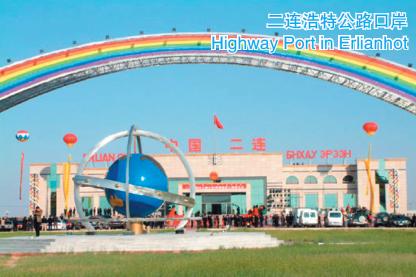
Highway
There are 16 national highways such as G109, G110, G111 and G203 as well as 51 provincial highways such as S101, S102, S201 and S301.There are a number of completed national trunk highways and important economic trunk highways, and a highway network of Three Transverse and Nine Longitudinal Highways and Twelve Outlets has been formed in the main. There is a mileage of 79,029 kms highways including 1,001-km expressways. The completed high grade ones include those from Hohhot to Baotou, from Baotou to Erdos, etc. In the completion years respectively those highways fulfilled a passenger transport of 286.04 million person-times, a passenger transportation volume of 17.90 billion person-kms, cargo transport of 510.20 million tons and cargo transportation volume of 32.34 billion ton-kms.
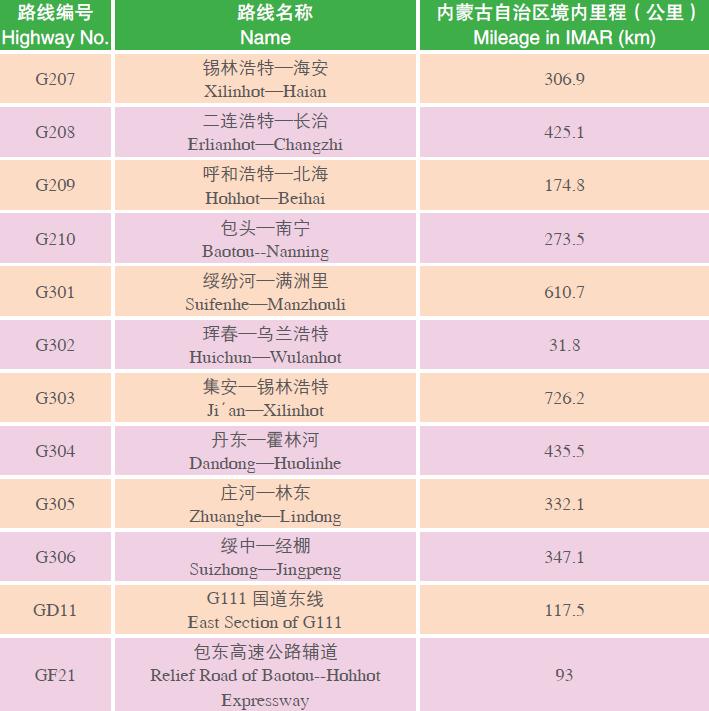
Railways
In IMAR there are 3 arterial railways, i.e. Beijing—Baotou, Baotou—Lanzhou and Jining—Erlianhot, and 7 feeder railways, (including a ring railway) i.e. Baotou— Baiyunebo, Baotou—Shijiazhuang, Wuhai— Jilantai, Haibowan—Gongusu, Baotou— Shenmubn and Guo—Cha. 2005 saw a mileage of 7,689 kms. Also that year saw a passenger transport of 32.59 million persontimes, a passenger transportation volume of 11.32 billion person-kms, cargo transport of 220.62 million tons and cargo transportation volume of 160.43 billion ton-kms.
Telecommunications
IMAR is accessible by post to all the countries and regions in the word, The telecommunications network covers all the urban and rural areas throughout the Region, with international direct dialing reaching over 200 countries and regions. By the end of 2005 the number of subscribers of fixed and mobile telephones had reached 12.396 million, a 1.431 million subscribers increase over the previous year. The popularization of phones(including fixed and mobile) arrives at 52 sets per 100 persons. There is a total service income of RMB 27.61 billion yuan for post and telecommunications of which telecommunications makes up RMB 26.72 billion yuan and post RMB 0.89 billion yuan.
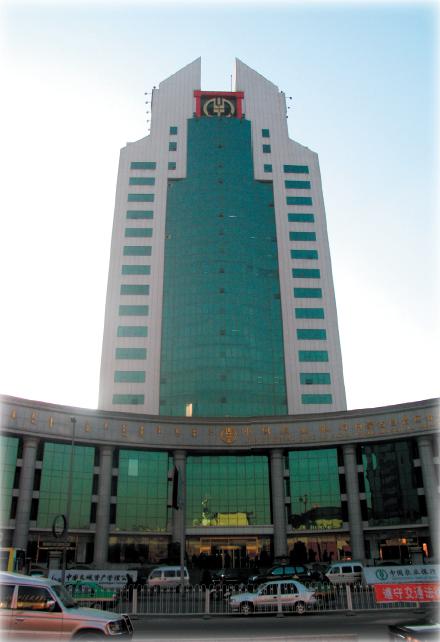
Finance and Insurance
There are financial institutions including IMAR Branch, Bank of China; IMAR Branch, Construction Bank of China; IMAR Branch, Industrial and Commercial Bank of China; IMAR Branch, China Bank for Agricultural Development. There are 5,660 business offices and a staff of 60,490 in that sector. Most of the institutions provide the international account-settlement service, international borrowing & lending and oversea banking. The end of 2005 saw a deposit balance of RMB 333.15 billion yuan for Chinese and foreign currencies, a loan balance of RMB 261.80 billion yuan. In 2005 there were 23 corp./groups including Yili Group, Ningcheng Laojiao Liquor Group, Hi-tech Corp. of Rare Earth, Mengniu Dairy Group and Baotou Aluminium Group, whose listed securities were admitted into the stock market. A fund of RMB 3.49 billion yuan by entry of stock market and by issuance of bonds.
The Chief Banks in IMAR
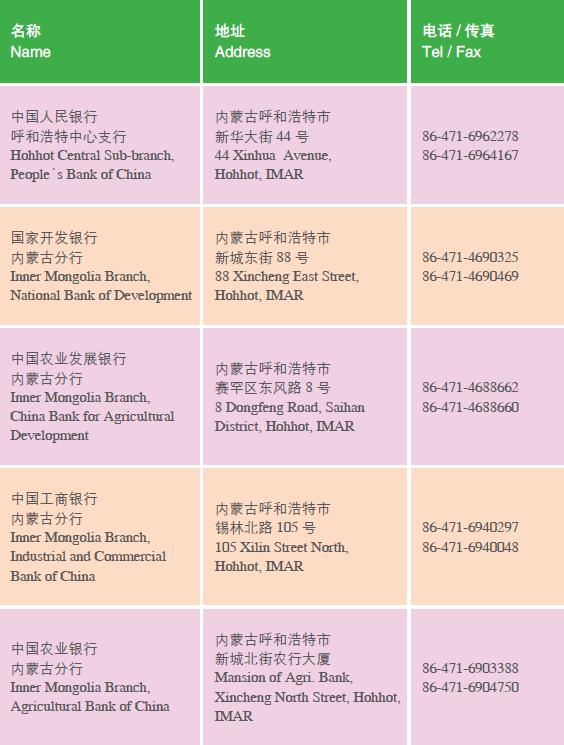
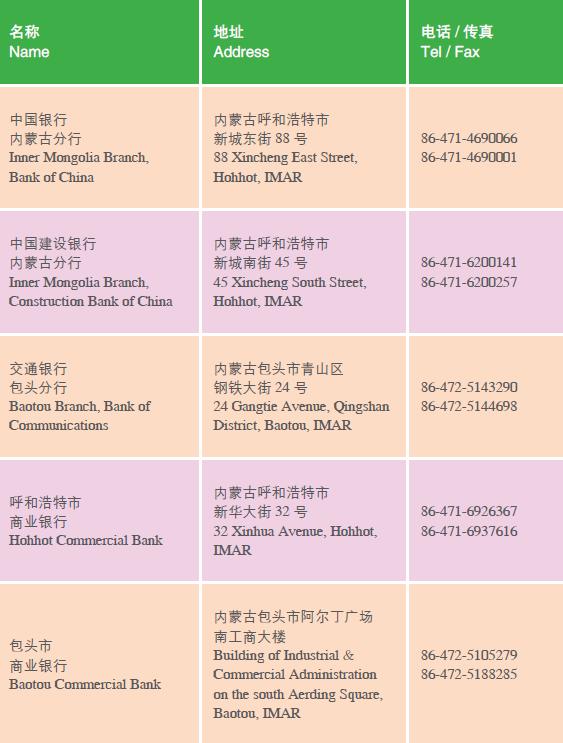
In 2005 IMARhad 9 insurance brances at IMAR level, 52 insurance intermediary institutions, as well as 2,349 agencies. By the end of that year the total property in that sector reached RMB 12.83 billion yuan, with the yearly achieved premium of RMB 6.09 billion yuan. The successive insurance payments for claims got to RMB 1.42 billion yuan. That sector has played the roles of booster and stabilizing the society.
(v) Foreign Exchange
In 2005 IMAR established economicties with more than 160 countries and regions, and friendly cooperation with the U.S., Russia, Japan, France and Mongolia Republic and so on, which has greatly improved the process of IMAR opening up to the outside.
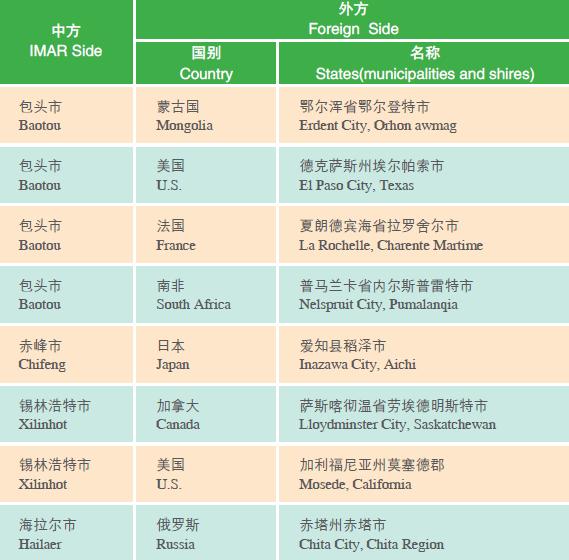
(vi)Higher Education and Scientific Research
There are 33 universities, colleges and institutes in IMAR such as well-known Inner Mongolia University, Agricultural University of Inner Mongolia and Normal University of Inner Mongolia, etc. In 2005 there were 229,400 undergraduate students in IMAR.
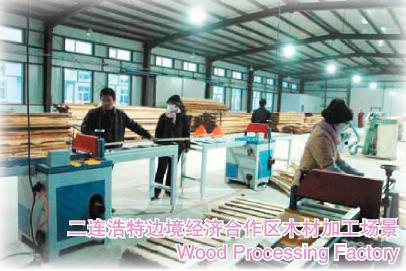
There are 139 state-owned scientific research bodies in various subjects and a professional technical staff of 534,900. 2005 saw 260 major scientific and technological achievements including 17 basic theoretical achievements,234 technological application achievements and 9 soft scientific achievements.101 projects won the awards for their achievements, of which 1 achievement won the state award and 100 achievements won IMAR-level awards. And there were 1,455 applications for patent and 845 patents were approved and authorized.1,160 technological contracts of various types were signed with the achieved sum of RMB 1.1 billion yuan arising there from. The achieved sum arising from exporting technology totaled RMB 90 million yuan.
(vii)Tourism
Scenery and Landscapes
IMAR is abundant in tourism resources and unique in types. It features distinctly the grassland scenes, rich amorous feelings of ethnic minority, and the long history and culture. The boundless sea of forestry and woods, the resounding deserts, the lakes extending far into the distance, the numerous rivers, mysterious warm springs and the white and silver ice world---all of them giving off limitless glamour. On the Hulunber Prairie, the Xilinguole Prairie and the Xilamuren Prairie, the weeds and reeds are knee-deep. You can enjoy the splendid view that herds of cattle and sheep submerged in the sea of luxuriant grass could only be seen when the grass bends as the wind blows. The fossils of giant dinosaurs, the Dayao Cultural Relics, the ancient Great Wall, the Graveyard of Genghis Khan, he Lamasery, the relics of Liao Dynasty, Gaxian Cave and the Tomb of Wang Zhaojun are all reflections of the IMAR's profound cultural realities beneath the surface. The Badanjilin Desert, the Tenggeli Desert, he Ulanbuhe Desert, he Maousu Desert and Qubqi Desert add radiance and beauty in contrast with the woods of diversiform-leaved poplars in Alashan, Heilihe River, Hulun Lake In Hulunber, the ice, snow and the warm spring in Aershan, the Daqinggou Natural Reserve in Tongliao and the Reserve of Virgin Forest in Helanshan Mountain. Those scenes constitute the grand views unique to IMAR.
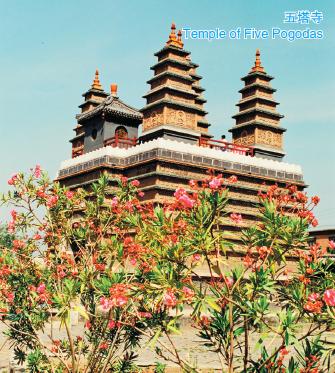
Temple of Five Pagodas
It is located in the hind street of Temple of Five Pogodas in Yuquan District in Hohhot and was built up in Yongzheng the fifth year in Qing Dynasty (1727).With the full name of Pagoda with Buddha's Relic on Diamond Pedestal and being 16.5 meters high, it is composed of the pogoda base, the diamond pedestal and 5 small and exquisite pogodas. It is unique in figure, dignified and graceful. To the north of the Temple there is a screen wall on which an astronomic map of over 1,500 stars, the sun's traveling orbit and the constellation of 28 stars is inscribed in the Mongolian language. It enjoys high value for scientific research.
Tomb of Wang Zhaojun
Situated in the southern suburb of Hohhot, it is also called Green Tomb and is the tomb of Wang Zhaojun in Han Dynasty according to the legend. Being 33 meters tall and with a basic coverage of about 13,000 sq. meters, it was rammed into gyroscope shape. In front of the Tomb there is a god's path, a decorated archway, a carved stone of a woman attendant in court and bronze statue, etc. The landscape around the Tomb is pleasant and full of unpredictable changes.
Wudang Lamasery
Located in Wudang Valley on deep Yinshan Mountain to the northwest of Baotou and 70 kms from Baotou City, it is the largest and most integrated lamasery of Tibetan style. It was built in Kangxi reign of Qing Dynasty and was repaired and expanded repeatedly in the reigns of Qianlong, Jiaqing and Guangxu thus developing into today's scale. Covering around 200,000 sq. meters, it consists mainly of 6 palaces, 3 halls, 1 room and 94 buildings for Lamas dwelling. The Lamasery in Tibetan construction style has 1,500 Buddhist statues in it, made of gold, copper, silver, wood and mud. Currently it is an important place for the disciples to conduct Buddhist activities and worship, where Manihui is held every year.
Graveyard of Genghis
Khan It falls in the territory of Yijin-huoluo Banner in Erdos. In the middle of the 15th century, the Ordos Mongolian tribe which had been guarding the tomb of Genghis Khan migrated to Hetao, thus moving the mausoleum Babaishi there. At present the Tomb covers a total area of 80 sq. kms including the Central Square of Genghis Khan, the Golden Tent of Iron Horse, the Square of Asia & Europe, the Museum of Mongolian History and the Temporary Dwelling Palace of Khan.
State-level Natural Reserve of Erdos Little Gull
It occupies an area of 88 sq. kms and has quite a few of lakes and islands. Residing on the Bird Island in the mid-south are the precious and rare aquatic birds--- little gulls as class-I-protected bird in the country, accounting for 60% of the worldwide in quantity. Furthermore, there are over 80 categories of other wetland birds such as aquatic and wading birds. It is an ideal resort for traveling.
Hulunber Prairie
It is a world known grassland with abundant water and grass. There are over 3,000 rivers crossing each other, over 500 lakes distributed here and there, as many as 3,000 kinds of vegetation, inhabited by more than 400 kinds of beasts and birds. It is an actually area of Green and Clean Land. It is a green sea of grass in summer, a golden world in fall and in white and silver coverings in winter, with forthcoming vigor.
Aershan
In Mongolian it means the Warm and Holy Water and is at the middle ridge of the Daxinganling Mountains. It is under the jurisdiction of the Xing'an League and with 63% forest coverage. The excellent surroundings for ecological tours make it the Natural Oxygen Bar and a Summer-avoiding Resort. The famous scenic spots include Tianchi, Lake of Cuckoo, Shitanglin, Santan Valley, Peak of Rose and Halaha River. You can as well enjoy the topographic features of volcanic slag, experience the icy and snowy world of jade-white and silver trees and blossom in the snow…
Diversiform-leaved Poplars in Ejina Banner
It is within the territory of Alashan League. The diversiform poplar is an old tree species with long span of life. The fossils of it discovered in Xinjiang Autonomous Region have a history of 6,500 years. In autumn the leaves of such trees, along the corridors from Murengaole to Gashunnur and Subonur, turn to golden color like a vast and golden ocean.
Badanjilin Desert
Being the third largest desert, it is in the middle part of Alashan League and covers an area of 49,200 sq. kms. The innumerable high hills of sounding sand in the desert and 114 little inland lakes add beauty and charm to each other, becoming an inimitable desert sight. Such pleasure programs as desert sightseeing, expedition and inspection are open to travelers.
Featured Products
Such products include black moss, fiddlehead, a kind of dried mushroom, black fungus, bear's-head mushroom, day lily, Cistanche salsa, sea-buckthorn, Chinese Ephedra, licorice, mastsutake, blueberry, Astragalus mongholicus, bitter apricot kernel, a kind of small melon seeds, naked oats and Hetao golden melon.
Black moss
Another popular name for it is Dimao, a kind of wild algae as thin as hair, rich in nutrition, healthful and also non-staple food. The black moss collected in Inner Mongolia amounts to 25-30 thousand kg annually and is of well-known quality.
Saline Cistanche
It is also called desert cistanche, a parasitic herbaceos perennial which is parasitized on the roots of red sahay, salt melon claws, zhenzhucao, nitraria grass and splendens. It is crowned with the renowned title of Desert Ginseng, as it is a good tonic.
Characteristic Food
Such food includes wholly-roast sheep, mutton slice in hot pot, roast gigot, Mongolian stewed lamb (eaten with hands), roast sheep back, koumiss, skin on boiled milk, cheese, milky tea, butter, grilled bottom of camel's foot, fried hump with sweet/sour sauce, steamed dumplings with the dough gathered at the top, oat noodles and buckwheat fl our noodles.
Wholly-roasted Sheep
Famous Mongolian delicacies which is prepared for grand feast on spectacular occasions or for entertaining distinguished guests. Normally, the fat sheep from the grassland about 20 kg is singled out to be butchered. And then the sheep wool is shaved but skin is retained, after which the abdomen is stuffed with such flavourings as onion, ginger, red pepper and salt, etc and is roasted into finished product. Being whole in figure, the sheep kneels on the square wodden plate appearing golden red in color. The skin is crisp while the mutton tastes tender and delicious.
Shaomei
Also called Shao'mei, famous in the City of Beijing as early as Qing Dynasty and is of long history and traditional taste in Hohhot. Worked with unique cooking skill and selected material, the flour wrapping does not tear easily and thin while the filling is made up of ground mutton in proper proportion of fat and lean, with full flavourings such as onion and ginger, etc. When they leave the steamer, Shaomei will give off fresh and pleasant smell. Shaomei tastes delicious but not greasy and is really the delicacy of foods.
Doing Business in IMAR of China:II.Economy
Doing Business in IMAR of China:III.Investment
Doing Business in IMAR of China:IV.Development Zones





